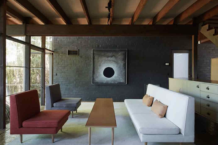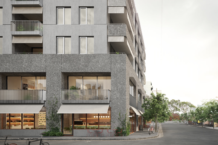Women Leading the Built Environment
People - by Open Journal
Danielle Savio and Justine Hadj are the women behind Gazella, an independent publication offering insights into inspiring females in the built environment. Having started in only June this year, Gazella has already featured the likes of Clare Cousins and the Executive Director of the Property Council, Jennifer Cunich. In an industry traditionally dominated by men, female representation remains underwhelming.
Gazella is an excellent initiative to support women across the sector, be it students just starting out, women well in the swing of their careers, or women in management looking to build a company culture that drives gender equality.
Danielle and Justine who interview, photograph and edit the site’s content around their full-time jobs in construction management, are themselves pertinent examples of extraordinary female talent in the built environment.
We asked them a few questions:
Tell us about Gazella, how did it come about and what’s your vision for it?
D: Gazella grew out of our passion for women in the built environment. Justine had the idea that we could interview women from all facets of the industry, as a way of inspiring ourselves, women like us, and women in the professional world in general. We decided to develop a blog, as we thought it was the most accessible platform.
J: Our mission is to inspire, celebrate and create awareness. We want to inspire women with role models and peers, celebrate their achievements and success and create awareness for women in the industry and those women at entry level. People need to be aware of their opportunities, of the roles they can have in the built environment. Women are doing amazing things out there. It’s important that that is acknowledged.
What was the ‘let’s go for it’ moment to start the page?
D: Our friendship flourished whilst we were both working on a construction site together. We had many a discussion together on the issues that we were experiencing ourselves juggling our careers and personal lives. There was a light bulb moment where we thought what a great idea it would be to share these similar experiences with others through a blog. A platform where everyone could engage with as much as, or as little as they wanted.
J: We would talk about our dreams for the blog. Plan things. Suggest ideas. It took us forever to just land on the name for the project! I think that was the clincher. The blog was a project where we could help promote and engage women and we hoped it would give back to the industry we were a part of. We needed Gazella in our lives.
While the built environment has been traditionally male dominated, the emphasis on supporting women is greater than ever. Do you think the industry is doing enough to hire women from entry level through to senior management?
D: It’s amazing that even in the 5 years we’ve been in the sector, how many females are entering the industry. The courses at universities have more attendance by females than ever before (see Professor Valerie Francis’ article on our blog for the stats!). By the same token, we have interviewed so many females in senior leadership roles who have spoken highly of the great support provided by their companies to get the to where they are today. The emphasis is there to have females in senior roles.
J: There is however still a long way to go. I think women in leadership roles still haven’t reached that critical mass. It’s tough to find examples of women who don’t fit into the cliches (women with no family or family with a nanny, or supermums who did it all). We need to see more successful examples of flexible work arrangements, part time or job shared roles. Displaying these options for women will increase numbers at both entry and senior levels of management. There still is vast opportunities to promote both trade and professions within the built environment to attract women into the industry.
Having females in senior management is crucial to shifting company culture and providing role models to younger staff, do you think introducing female quotas to executive and senior management roles is needed?
D: It’s always that old argument of merit vs. quotas but believe me, no one will ever be appointed to a senior role or a board, without having proved their worth! Quotas ensure women are considered for a role. They emphasise that a balance between men and women is beneficial and they bring awareness to the imbalance that is apparent in most senior echelons. I think having women in senior roles changes the entire culture and dynamic of a workplace. It shows their capabilities are equally valued, regardless of their gender. That is very important for women – to see they can make it to the top.
Interest in working in the built environment is often sparked at school, what more do you think the industry could be doing to reach out to high school aged students, promoting the benefits of construction, engineering, property development, architecture and town planning when girls are frequently channeled into humanities?
J: This is so critical and it’s something we are passionate about. How to reach women at entry level!? We hope to be involved in promoting the built environment to schools and it’s the next stage of the Gazella project. We have found through our interviews that many women see architecture as the happy medium. And now, more than ever, there are a lot more females in architecture courses than males.
D: I don’t think it even crosses most girls minds to consider a trade or to go into construction or project management. It’s a shame, because as an industry, it is fairly well paid and has a fair degree of job security and upwards mobility. Schools really need to take more responsibility in general, for not engaging in age old stereotypes of what girls and boys want to do. Hopefully through creating more awareness, we can engage a greater audience and reception from schools.
Retention of female staff from entry through to senior management is often reliant of family focused office cultures that support parental leave and offer flexible work options for working mothers. How do you think the built environment sector compares to other industries? What more can be done?
J: The argument is that it’s hard in the construction/design/property industry, because as a whole our roles are often demanding, with long hours, and deep histories. But, there is still opportunity within built environment sector to offer alternative arrangements to create greater flexibility. There are some great workplaces out there creating amazing initiatives to lead the industry on this issue. Establishing flexible policies and really making an effort to change the current culture is key. It’s also obvious from the women we interview too, that an understanding and supportive manager, and management who are willing to create flexibility, is key to a successful environment for women. We are certainly of the belief that the sector could use examples of good practices from other industries and implement them successfully within our own.
You’ve interviewed a number of women already from a variety of professions in the sector, do you feel some professions are more supportive of female leadership than others? Do you think a smaller or a larger office culture is more beneficially for supporting women in the built environment?
D: Some areas of our sector are more traditionally female and some areas have absorbed a female contingent more readily. It’s hard to say whether this is because of a particular workplace culture, or maybe it’s just that females find it easy to adjust or assimilate into some workplaces. What’s clear is that regardless of whether it’s a large or small workplace, it’s the culture displayed from the top that counts. It’s the companies usually with robust policy and clear strategies for men and women to find flexibility and work-life balance that create a supportive environment.
J: Without that strong stance from the top, without those flexible workplace arrangements in place, women are often left wondering that if they take a break for family, will they ultimately lose out professionally. Uncertainty is a real concern and amongst women, it can cause a lot of stress or pressure. I think our managers need more support and learning, to ensure they address the needs of all their staff on an individual basis.

A full list of Gazella’s interviews can be found here.








